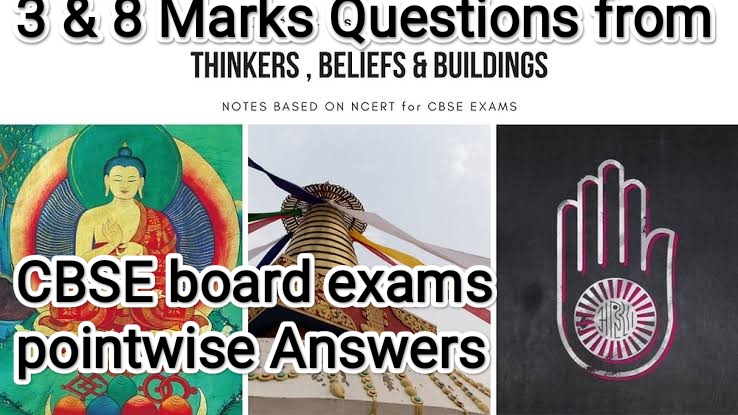3 and 8 marks questions from last 25 years cbse board
3-Mark Questions and Answers
1. Explain the main teachings of Mahavira.(2017)
- Emphasized Ahimsa (non-violence) towards all living beings.
- Advocated truthfulness, celibacy, and self-discipline.
- Liberation (moksha) achieved by freeing the soul from karmic bondage.
2. What are the four noble truths taught by Buddha?(2015)
- Life is full of suffering (Dukkha).
- Suffering is caused by desire and attachment.
- There is an end to suffering (Nirvana).
- The way to end suffering is the Eightfold Path.
3. Define the Eightfold Path in Buddhism. (2013)
- Right View: Understand Four Noble Truths.
- Right Intention: Commitment to self-improvement.
- Right Speech: Speak truthfully and kindly.
- Right Action: Ethical conduct.
- Right Livelihood: Harmless earning.
- Right Effort: Cultivate positive mind.
- Right Mindfulness: Awareness of body and mind.
- Right Concentration: Meditation practice.
4. Mention any three architectural features of the Sanchi Stupa. (2010)
- Hemispherical dome representing the universe.
- Harmika (square railing) on top symbolizing heaven.
- Four gateways (toranas) with carvings depicting Buddha’s life.
5. Who was Ashoka and why is he important for Buddhism? (2005)
- Mauryan emperor who embraced Buddhism.
- Spread Buddhism through missionaries.
- Built stupas and pillars with inscriptions promoting Dharma.
6. What is the significance of the Jataka tales in Buddhism? (2011)
- Stories of Buddha’s previous lives.
- Teach moral lessons like kindness and sacrifice.
- Helped spread Buddhist values through art and stories.
7. Name three important Buddhist sites related to Buddha’s life. (2016)
- Bodh Gaya (enlightenment).
- Sarnath (first sermon).
- Kushinagar (death or Mahaparinirvana).
8. What role did Ashoka’s edicts play in the spread of Buddhism? (2009)
- Communicated moral teachings.
- Promoted non-violence and tolerance.
- Helped spread Buddhism within and outside India.
9. What is the main message of the Buddhist concept of Nirvana? (2010)
- Liberation from birth and death cycle.
- End of suffering and desire.
- Ultimate spiritual goal.
10. Mention three differences between Hinayana and Mahayana Buddhism. (2010)
- Hinayana focuses on individual salvation; Mahayana on saving all beings.
- Hinayana uses Pali texts; Mahayana uses Sanskrit.
- Mahayana worships Bodhisattvas; Hinayana does not.
8-Mark Questions and Answers
1. Describe the main ideas of Jainism and how they influenced Indian society. ( 2018)
- Jainism teaches Ahimsa (non-violence) as highest virtue.
- Emphasizes truthfulness, non-stealing, celibacy, detachment.
- Liberation by freeing soul from karma.
- Promoted vegetarianism and respect for all life.
- Influenced trade ethics and Indian culture.
- Developed Jain art and temple architecture.
- Encouraged asceticism and self-discipline.
- Added religious diversity and coexistence in India.
2. Explain the key teachings of Buddhism and how they differ from Hindu beliefs. (2012)
- Four Noble Truths and Eightfold Path central.
- Rejects Vedic authority and caste system.
- Focus on individual effort for Nirvana, not rituals.
- Belief in Anatta (no permanent soul).
- Different interpretation of karma and rebirth.
- Emphasizes meditation and ethical conduct.
- Inclusive and accessible to all social classes.
- Challenged orthodox Hindu beliefs.
3. Discuss the architectural significance of the Great Stupa at Sanchi. (2008)
- One of oldest stone structures, symbolizing Buddha’s presence.
- Hemispherical dome represents universe and burial mound.
- Harmika and chhatra symbolize cosmic elements.
- Four gateways (toranas) with carved scenes from Buddha’s life.
- Influenced Buddhist architecture across Asia.
- Place for meditation and worship without idols.
- Reflects advanced stone carving and symbolism.
- Spread Buddhist teachings through visual stories.
4. How did the teachings of Buddha and Mahavira influence the culture and society of ancient India? (2003)
- Preached non-violence and compassion.
- Rejected caste system; promoted equality.
- Influenced laws and social practices.
- Encouraged monastic life and renunciation.
- Promoted vegetarianism and respect for life.
- Inspired art, literature, and architecture.
- Added to religious diversity and philosophical debates.
- Influenced rulers like Ashoka.
5. Discuss the architectural features and religious significance of Ajanta caves. (2014)
- Rock-cut monasteries (viharas) and prayer halls (chaityas).
- Murals and sculptures depict Buddha’s life and Jataka tales.
- Show high artistic and architectural skills.
- Centers for learning and meditation.
- Helped preserve Buddhist teachings through art.
- Paintings with vivid colors and expressions.
- Influenced later temple architecture.
- UNESCO World Heritage site.
6. Explain the concepts of Ahimsa and Karma in Jainism. (2006)
- Ahimsa means total non-violence to all beings.
- Avoid harm even to insects and plants.
- Karma is the moral consequences of actions.
- Good deeds reduce karmic bondage; bad deeds increase it.
- Liberation (moksha) by cleansing karma.
- Strict discipline to avoid new karma.
- Ahimsa influenced Indian vegetarianism.
- Karma explains moral responsibility.
7. Describe the contributions of Ashoka to Indian art and architecture. (2000)
- Built stupas (Sanchi) and pillars with inscriptions.
- Promoted Buddhist architecture with symbolism.
- Pillars have carved capitals like Lion Capital of Sarnath.
- Edicts spread moral teachings and dhamma.
- Constructions served as pilgrimage centers.
- Encouraged stone carving and sculpture.
- Influenced Buddhist art beyond India.
- Integrated religion and statecraft.
8. Explain the role of monasteries (viharas) in the spread of Buddhism. (2007)
- Viharas housed monks for living and study.
- Centers for learning, meditation, and scriptures.
- Preserved Buddhist teachings and culture.
- Often attached to stupas and prayer halls.
- Attracted pilgrims, spreading Buddhism locally and abroad.
- Offered community services like education.
- Supported by kings and merchants.
- Architecture reflected religious ideals and promoted art.







